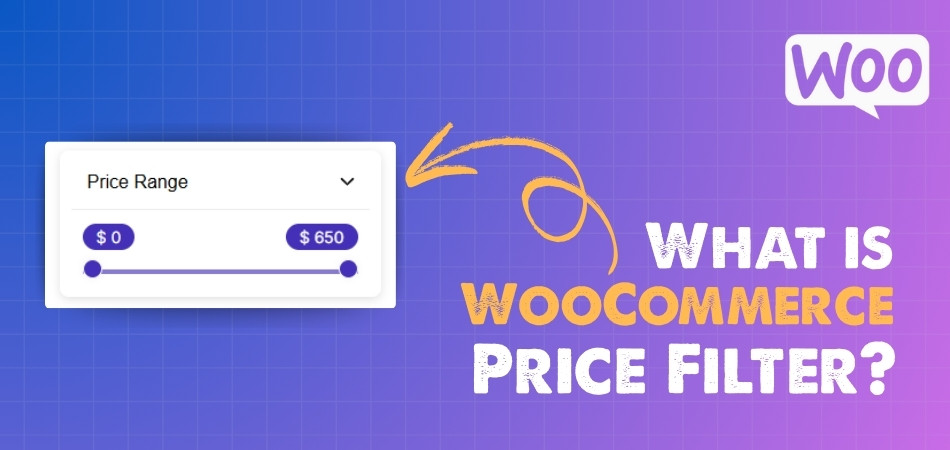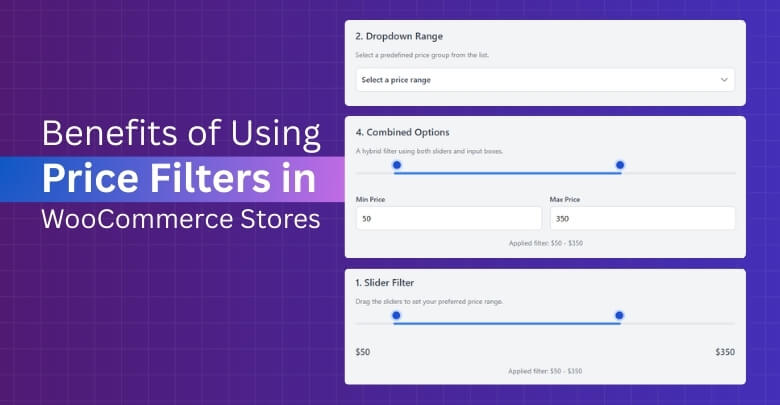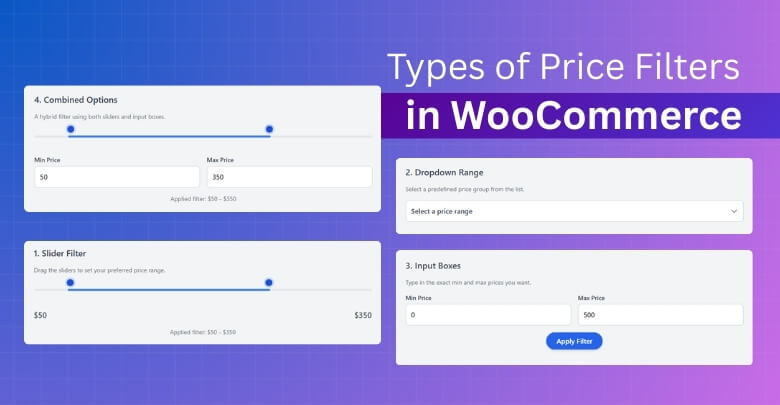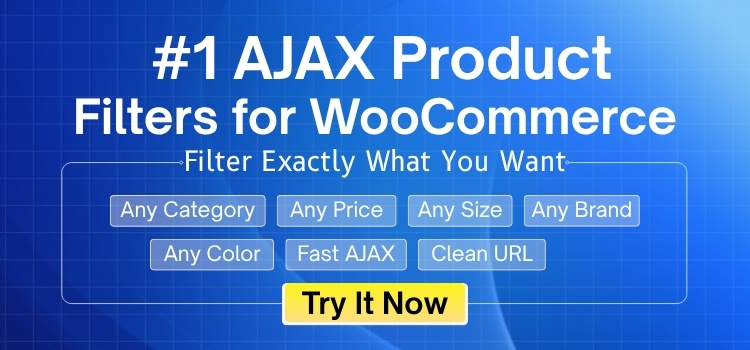A filter makes shopping easier because it sorts out what matters and removes what does not. It keeps things simple, clear, and organized while searching for products. Many people who shop online often think about budgets, which leads them to wonder what is WooCommerce price filter?
WooCommerce Price Filter is a built-in WooCommerce tool that allows customers to set minimum and maximum price ranges for products. It displays only items that fall within the chosen budget, including sale and variation prices. This filter improves shopping by saving time, reducing confusion, and helping customers focus only on affordable products.
If you are curious to understand more, this article covers everything about the price filter. You will learn how it works, the benefits it offers, and the different types available. Keep reading, because every important detail about this feature is explained here.
What is WooCommerce Price Filter?
WooCommerce Price Filter is a simple tool that makes online shopping easier. It allows customers to set a price range and see only items that fit their budget. This tool saves time and reduces confusion while browsing many products together. From its basic meaning to buyer benefits, here’s a clear look at how the WooCommerce Price Filter improves shopping.

Basic Meaning
This feature is a filter that sorts products by price range. It lets buyers decide what minimum and maximum prices should be shown. The tool then displays only items that match the chosen limits. It works instantly and ensures customers can focus on affordable products.
Main Purpose
The filter aims to help customers quickly locate products that match their budget. Many shoppers want to avoid scrolling through expensive or irrelevant options. This filter removes that hassle and shortens the browsing process easily. It makes online shopping more convenient and reduces decision-making stress.
Display Style
Often shown as a slider or list, this filter is simple. Buyers can drag sliders or enter values to set a price range. Once applied, the tool updates product results that fit the selection. This design helps people understand the filter’s use without any instructions.
Product Sorting
Instead of showing every product, it narrows the list by price. Sale items and variable prices are also included in this calculation. Customers can then see only the items that match their budget. This makes results accurate and tailored to what the shopper needs.
Data Source
The tool uses product prices as its base to filter results effectively. It includes regular product prices, discounted prices, and prices of variations. This ensures no important product gets hidden from the results accidentally. Customers always get an updated and reliable view of store items.
Buyer Benefit
Using the filter, shoppers save time by avoiding unwanted high-priced products. They feel more comfortable when advanced tools like the wooCommerce Ajax product filter plugin make browsing easier. It allows them to focus on realistic options without distractions. This small step improves satisfaction and creates a smoother shopping process.
Store Advantage
For sellers, this tool improves product visibility and increases customer engagement quickly. When customers see only products within their range, they feel encouraged. This raises the chance of adding items to the cart. It often leads to more purchases and higher store sales overall.
Overall Value
The price filter adds convenience and trust to the shopping environment. It balances customer needs with store performance in a smart way. Easy filtering keeps visitors happy and willing to stay longer. The end result is better shopping satisfaction and improved sales performance.
WooCommerce Price Filter is not just a simple tool; it is a helpful guide for every customer. It gives shoppers better control over what they want to see. It also creates a smoother experience that saves time for everyone. Both buyers and sellers benefit when the filter works properly.
How the WooCommerce Price Filter Works?
When browsing an online store, customers want an easy way to find products that match their budget. A price filter is the tool that makes this possible in a simple way. It allows visitors to set their own limits. To understand it better, let’s look at the details below.
Price Range Selection
The main idea is that shoppers can select a minimum and maximum price range. By doing this, they remove products that are either too costly or too cheap. This creates a personalized list that fits their exact budget. It makes product searching simple and very quick.
Automatic Filtering
Once the price range is set, the filter works instantly without delay. Customers immediately see a new list of products that match their chosen values. This saves time and energy since irrelevant items are no longer displayed. It helps create a smoother shopping experience every time.
Real-Time Updates
The filter constantly updates product results as the chosen range changes. When a shopper adjusts the slider or enters new numbers, the list refreshes. This keeps the view relevant and clear at every step. It allows customers to make decisions with confidence and comfort.
Sale Price Consideration
Discounted items and sale prices are also included in the price filter. This means buyers do not miss out on special offers while searching. The system checks all pricing types before showing updated results. It ensures a complete product list based on true value.
Easy Shopping Experience
By narrowing the product list to a chosen range, shopping feels more organized. Customers do not waste time browsing unnecessary items or irrelevant prices. Instead, they focus only on products that match their budget. This simple function improves satisfaction and keeps online shopping stress-free.
The WooCommerce Price Filter gives buyers better control and makes shopping easier. It reduces confusion by showing only products that match set limits. This builds trust between the store and the customer. Overall, it makes online shopping smooth, quick, and enjoyable.
Benefits of Using Price Filters in WooCommerce Stores
Price filters help customers find products that match their budget quickly. Instead of looking through every item, they can narrow down choices to what they can actually afford. This makes online shopping more organized and enjoyable. Let’s explore some benefits in detail.

Faster Shopping
Shoppers do not want to waste time scrolling through hundreds of products. A price filter lets them instantly remove items outside their budget. This makes it simple to focus only on the products they can afford. Faster shopping means happier customers who are more likely to stay.
Better Control
When people shop online, they like having control over what they see. Price filters allow them to decide the range that suits their budget. This helps them avoid distractions and unnecessary stress. With this freedom, customers enjoy their shopping experience much more.
Improved Conversions
Stores benefit when customers find what they want quickly and easily. Price filters reduce the chance of people leaving without buying. By guiding them to affordable options, filters encourage more sales. This small feature can make a big difference in conversion rates.
Less Confusion
Without filters, shoppers often feel lost when browsing long product lists. Price filters help organize products into clear groups based on budgets. This cuts out the noise and makes choices easier. A smoother shopping process builds trust and reduces confusion during product selection.
Extra Flexibility
Different shoppers have different spending limits, and filters respect that. By offering various ranges, stores give people flexible options to shop their way. Price filters make shopping smoother, but store owners should also be aware that common filter compatibility issues in WooCommerce can occasionally prevent them from working as expected.
Price filters create a stress-free shopping process for every type of customer. They save time, build confidence, and make products easier to find. Stores that use them well see more sales and happier buyers. Adding price filters is a simple way to improve shopping.
Different Types of Price Filters in WooCommerce
Price filters are simple tools that help shoppers quickly narrow down choices. They make the process of finding the right product faster and more enjoyable. Each type of price filter works differently and has unique strengths. Keep reading to learn about the common types.

Slider Filter
Slider filters let customers drag a bar to set their preferred price range. It feels simple and interactive, making it fun to use. This type works best when shoppers want flexibility instead of fixed price steps. It gives freedom to set a custom budget range.
Dropdown Range
A dropdown range shows a list of price groups like “Under $50” or “$100–$200.” Customers just click once to apply the filter. This is very useful when you want to save page space. It also guides shoppers with ready-made budget options to choose from.
Input Boxes
With input boxes, shoppers type the lowest and highest price they want. This option is helpful for people who already know their spending limit. It allows full control over budget selection. While less visual, it’s precise and very straightforward to use.
Combined Options
Some stores mix different price filters together on one page. For example, they may show sliders for flexible ranges and dropdowns for fixed groups. This gives shoppers more ways to search based on their needs. A combined setup often makes the shopping process easier.
Style Matching
Choosing the right filter type depends on your store design and customer habits. Sliders work well for interactive layouts, dropdowns fit clean designs, and input boxes match simple themes. Picking the right style improves both the appearance and usability of the store filters.
Along with sliders and dropdown ranges, some stores prefer using shortcodes for price filtering, though it’s important to keep in mind the safe use of filter shortcodes to avoid conflicts.
SEO Benefits of Using WooCommerce Price Filters
Price filters can do more than help people shop with ease. When they are set up the right way, they also support your category pages. Clean filters can shape content that search engines understand well. Keep reading to see practical tips that help.
- Descriptive URLs: Use readable filter URLs that show the price range clearly, so search engines and people both understand the page purpose without confusion or extra effort.
- Unique Titles: Write page titles that include the category and price range, which helps search engines link the page to real buying intent and specific budgets.
- Helpful Headings: Add clear H1 or H2 headings that mention the price range, so the page content matches the filter and guides people with simple language.
- Focused Content: Place a short paragraph near the top that explains what shoppers can find in that price range, keeping it friendly and easy to scan quickly.
- Smart Internal Links: Link from broader categories to filtered price pages, helping search engines crawl deeper while giving visitors a direct path to focused product lists.
- Canonical Tags: Set canonical tags when many filter combinations exist, preventing duplicate content problems and keeping ranking strength focused on the most important pages.
- Index Rules: Choose which filtered pages should be indexed, only keeping valuable ranges public while marking low-value combinations as noindex to avoid thin or messy pages.
- Consistent Breadcrumbs: Show breadcrumbs that match the price path, so search engines learn the structure and visitors always know where they are within the store.
- Fast Loading: Keep filtered pages light with caching and clean queries, which helps rankings because search engines reward smooth pages that respond quickly on all devices.
- Clear Schema: Use product and breadcrumb schema where possible, helping search engines read prices, stock, and structure, which can improve rich results and page clarity.
Well-planned price filters can shape focused pages that search engines appreciate. Clear text, tidy links, and smart tags reduce clutter and improve clarity. Small steps add up fast. Set filters carefully, and your category pages can grow stronger.
FAQs About What is WooCommerce Price Filter?
A WooCommerce price filter sounds like a small feature, but it often raises questions about setup, use, and best practices. These FAQs will clear up common doubts and give you practical answers. Read them to better understand how price filters work.
Can Price Filters Work With Variable Products?
Yes, price filters can work with variable products like clothing with different sizes. The filter reads the lowest and highest prices from the variations. This ensures that shoppers see the correct options. It makes the shopping process clear and fair for all buyers.
Do Price Filters Support Sale Prices?
Sale prices are included in the filter results automatically. If a product is discounted, the filter considers the reduced price. This way, customers can find the best deals easily. It also helps stores highlight promotions without any extra effort.
Can I Use Price Filters With Custom Themes?
Most price filters work with custom themes as long as the theme supports WooCommerce. If something looks off, it may need styling fixes. Many plugins let you add custom CSS for adjustments. Testing filters after theme changes is always a good idea.
Are Price Filters Mobile Friendly?
Yes, modern price filters are designed to work well on mobile devices. Sliders adjust easily to smaller screens, and dropdowns save space. Input boxes are also simple to use on phones. Always test filters on mobile to keep the experience smooth.
Can Filters Be Placed Anywhere on the Page?
Price filters can be placed in sidebars, headers, or even inside product lists. Most plugins use widgets or shortcodes to add them. The best location depends on store design and customer habits. Clear placement ensures shoppers notice and use them.
Do Price Filters Affect Page Speed?
Filters can affect page speed if they load too many queries. Using Ajax helps update results without refreshing the page. Good caching also keeps performance smooth. A reliable hosting plan ensures filters run fast, even with many products.
Can Filters Be Combined With Other Filters?
Yes, price filters can be used together with checkboxes, categories, or tags. Combining them helps shoppers narrow down results more precisely. For example, they can select “red shirts under $50.” This makes searching more flexible and effective for everyone.
Are Price Filters Easy to Translate?
Price filters can be translated for stores with multiple languages. Most plugins support popular translation tools. Shoppers will see ranges in their language, keeping the experience natural. Always test translations to make sure numbers and text display correctly.
Do Price Filters Help With Customer Trust?
Yes, clear price filters build trust by making results honest and transparent. Customers feel comfortable when they control what they see. They know prices fit their budget without hidden surprises. Trust often leads to longer visits and repeat purchases.
What Happens If Filters Show No Results?
Sometimes, filters may show zero results if no product matches. Good plugins let you display a friendly message instead of a blank page. You can suggest related categories or wider ranges. This keeps customers engaged instead of leaving the store.
Conclusion
The WooCommerce Price Filter is a feature that gives shoppers control by letting them select a budget range and view only products that fit. It saves time, reduces stress, and makes browsing organized. This short explanation fully answers what is WooCommerce price filter.
For the best results, always keep product prices updated, test the filter on different devices, and make sure it loads quickly. Using these small steps, you can improve both customer experience and store performance. Wishing you success with your WooCommerce store.
